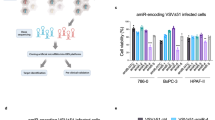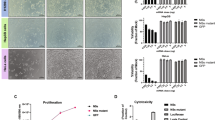Abstract
Overexpression of myeloid cell leukemia 1 protein (Mcl-1), an anti-apoptotic B-cell lymphoma 2 (Bcl-2) family member, contributes to chemotherapy resistance of tumors. The short half-life of Mcl-1 makes it an interesting target for therapeutic agents that negatively interfere with cellular protein biosynthesis, such as oncolytic viruses. Vesicular Stomatitis Virus (VSV) has been established as the oncolytic virus that efficiently disrupts de novo protein biosynthesis of infected cells. Here, we show that after VSV infection, Mcl-1 protein levels rapidly declined, whereas the expression of other members of the Bcl-2 family remained unchanged. Mcl-1 elimination was a consequence of proteasomal degradation, as overexpression of a degradation-resistant Mcl-1 mutant restored Mcl-1 levels. Mcl-1 rescue inhibited apoptosis and thereby confirmed that Mcl-1 downregulation contributes to VSV-induced apoptosis. In vitro, VSV virotherapy in combination with chemotherapy revealed an enhanced therapeutic effect compared with the single treatments, which could be reverted by Mcl-1 rescue or RNA interference (RNAi)-mediated knockdown of pro-apoptotic Bax and Bak proteins. Finally, in a tumor mouse model, combinations of doxorubicin and VSV showed a superior therapeutic efficacy compared with VSV or doxorubicin alone. In summary, our data indicate that VSV virotherapy is an attractive strategy to overcome tumor resistance against conventional chemotherapy by elimination of Mcl-1.
This is a preview of subscription content, access via your institution
Access options
Subscribe to this journal
Receive 12 print issues and online access
$259.00 per year
only $21.58 per issue
Buy this article
- Purchase on Springer Link
- Instant access to full article PDF
Prices may be subject to local taxes which are calculated during checkout







Similar content being viewed by others
References
Barber GN . Vesicular stomatitis virus as an oncolytic vector. Viral Immunol 2004; 17: 516–527.
Balachandran S, Porosnicu M, Barber GN . Oncolytic activity of vesicular stomatitis virus is effective against tumors exhibiting aberrant p53, Ras, or myc function and involves the induction of apoptosis. J Virol 2001; 75: 3474–3479.
Stojdl DF, Lichty B, Knowles S, Marius R, Atkins H, Sonenberg N et al. Exploiting tumor-specific defects in the interferon pathway with a previously unknown oncolytic virus. Nat Med 2000; 6: 821–825.
Balachandran S, Barber GN . Defective translational control facilitates vesicular stomatitis virus oncolysis. Cancer Cell 2004; 5: 51–65.
Barber GN . VSV-tumor selective replication and protein translation. Oncogene 2005; 24: 7710–7719.
Blondel D, Harmison GG, Schubert M . Role of matrix protein in cytopathogenesis of vesicular stomatitis virus. J Virol 1990; 64: 1716–1725.
Renukaradhya GJ, Khan MA, Shaji D, Brutkiewicz RR . The VSV matrix protein impairs CD1d-mediated antigen presentation through activation of the p38 MAPK pathway. J Virol 2008; 82: 12535–12542.
Black BL, Lyles DS . Vesicular stomatitis virus matrix protein inhibits host cell-directed transcription of target genes in vivo. J Virol 1992; 66: 4058–4064.
Ahmed M, Lyles DS . Effect of vesicular stomatitis virus matrix protein on transcription directed by host RNA polymerases I, II and III. J Virol 1998; 72: 8413–8419.
Faria PA, Chakraborty P, Levay A, Barber GN, Ezelle HJ, Enninga J et al. VSV disrupts the Rae1/mrnp41 mRNA nuclear export pathway. Mol Cell 2005; 17: 93–102.
Petersen JM, Her LS, Varvel V, Lund E, Dahlberg JE . The matrix protein of vesicular stomatitis virus inhibits nucleocytoplasmic transport when it is in the nucleus and associated with nuclear pore complexes. Mol Cell Biol 2000; 20: 8590–8601.
Petersen JM, Her LS, Dahlberg JE . Multiple vesiculoviral matrix proteins inhibit both nuclear export and import. Proc Natl Acad Sci USA 2001; 98: 8590–8595.
von KC, van Deursen JM, Rodrigues JP, Sitterlin D, Bachi A, Wu X et al. Vesicular stomatitis virus matrix protein inhibits host cell gene expression by targeting the nucleoporin Nup98. Mol Cell 2000; 6: 1243–1252.
Enninga J, Levy DE, Blobel G, Fontoura BM . Role of nucleoporin induction in releasing an mRNA nuclear export block. Science 2002; 295: 1523–1525.
Connor JH, Lyles DS . Vesicular stomatitis virus infection alters the eIF4F translation initiation complex and causes dephosphorylation of the eIF4E binding protein 4E-BP1. J Virol 2002; 76: 10177–10187.
Connor JH, Lyles DS . Inhibition of host and viral translation during vesicular stomatitis virus infection. eIF2 is responsible for the inhibition of viral but not host translation. J Biol Chem 2005; 280: 13512–13519.
Cory S, Huang DC, Adams JM . The Bcl-2 family: roles in cell survival and oncogenesis. Oncogene 2003; 22: 8590–8607.
Warr MR, Shore GC . Unique biology of mcl-1: therapeutic opportunities in cancer. Curr Mol Med 2008; 8: 138–147.
Nguyen M, Marcellus RC, Roulston A, Watson M, Serfass L, Murthy Sr M et al. Small molecule obatoclax (GX15-070) antagonizes MCL-1 and overcomes MCL-1-mediated resistance to apoptosis. Proc Natl Acad Sci USA 2007; 104: 19512–19517.
Tagscherer KE, Fassl A, Campos B, Farhadi M, Kraemer A, Bock BC et al. Apoptosis-based treatment of glioblastomas with ABT-737, a novel small molecule inhibitor of Bcl-2 family proteins. Oncogene 2008; 27: 6646–6656.
Cuconati A, Mukherjee C, Perez D, White E . DNA damage response and MCL-1 destruction initiate apoptosis in adenovirus-infected cells. Genes Dev 2003; 17: 2922–2932.
Wirth T, Kuhnel F, Fleischmann-Mundt B, Woller N, Djojosubroto M, Rudolph KL et al. Telomerase-dependent virotherapy overcomes resistance of hepatocellular carcinomas against chemotherapy and tumor necrosis factor-related apoptosis-inducing ligand by elimination of Mcl-1. Cancer Res 2005; 65: 7393–7402.
Clohessy JG, Zhuang J, Brady HJ . Characterisation of Mcl-1 cleavage during apoptosis of haematopoietic cells. Br J Haematol 2004; 125: 655–665.
Herrant M, Jacquel A, Marchetti S, Belhacene N, Colosetti P, Luciano F et al. Cleavage of Mcl-1 by caspases impaired its ability to counteract Bim-induced apoptosis. Oncogene 2004; 23: 7863–7873.
Michels J, O'Neill JW, Dallman CL, Mouzakiti A, Habens F, Brimmell M et al. Mcl-1 is required for Akata6 B-lymphoma cell survival and is converted to a cell death molecule by efficient caspase-mediated cleavage. Oncogene 2004; 23: 4818–4827.
Weng C, Li Y, Xu D, Shi Y, Tang H . Specific cleavage of Mcl-1 by caspase-3 in tumor necrosis factor-related apoptosis-inducing ligand (TRAIL)-induced apoptosis in Jurkat leukemia T cells. J Biol Chem 2005; 280: 10491–10500.
Gadaleta P, Perfetti X, Mersich S, Coulombie F . Early activation of the mitochondrial apoptotic pathway in Vesicular Stomatitis virus-infected cells. Virus Res 2005; 109: 65–69.
Gaddy DF, Lyles DS . Vesicular stomatitis viruses expressing wild-type or mutant M proteins activate apoptosis through distinct pathways. J Virol 2005; 79: 4170–4179.
Gaddy DF, Lyles DS . Oncolytic vesicular stomatitis virus induces apoptosis via signaling through PKR, Fas, and Daxx. J Virol 2007; 81: 2792–2804.
Lee HK, Lund JM, Ramanathan B, Mizushima N, Iwasaki A . Autophagy-dependent viral recognition by plasmacytoid dendritic cells. Science 2007; 315: 1398–1401.
Sharif-Askari E, Nakhaei P, Oliere S, Tumilasci V, Hernandez E, Wilkinson P et al. Bax-dependent mitochondrial membrane permeabilization enhances IRF3-mediated innate immune response during VSV infection. Virology 2007; 365: 20–33.
Lallemand C, Blanchard B, Palmieri M, Lebon P, May E, Tovey MG . Single-stranded RNA viruses inactivate the transcriptional activity of p53 but induce NOXA-dependent apoptosis via post-translational modifications of IRF-1, IRF-3 and CREB. Oncogene 2007; 26: 328–338.
Zhong Q, Gao W, Du F, Wang X . Mule/ARF-BP1, a BH3-only E3 ubiquitin ligase, catalyzes the polyubiquitination of Mcl-1 and regulates apoptosis. Cell 2005; 121: 1085–1095.
Pattingre S, Tassa A, Qu X, Garuti R, Liang XH, Mizushima N et al. Bcl-2 antiapoptotic proteins inhibit Beclin 1-dependent autophagy. Cell 2005; 122: 927–939.
Maiuri MC, Le TG, Criollo A, Rain JC, Gautier F, Juin P et al. Functional and physical interaction between Bcl-X(L) and a BH3-like domain in Beclin-1. EMBO J 2007; 26: 2527–2539.
Erlich S, Mizrachy L, Segev O, Lindenboim L, Zmira O, di-Harel S et al. Differential interactions between Beclin 1 and Bcl-2 family members. Autophagy 2007; 3: 561–568.
Tumilasci VF, Oliere S, Nguyen TL, Shamy A, Bell J, Hiscott J . Targeting the apoptotic pathway with BCL-2 inhibitors sensitizes primary chronic lymphocytic leukemia cells to vesicular stomatitis virus-induced oncolysis. J Virol 2008; 82: 8487–8499.
Acknowledgements
We thank Meriame Nassiri and Gisela Weier for their excellent assistance in animal experiments, preparation of tissue sections and histological stainings. Financial support was provided by: EU-project, Netsensor' (Contract no. 12948), Deutsche Forschungsgemeinschaft (DFG) clinical research group KFO119/2, DFG KU 1213/3-2, Deutsche Krebshilfe 10-2078-Ku2. We thank the Foundation of the German Economy (Stiftung der Deutschen Wirtschaft) for financing the position of Peter Schache.
Author information
Authors and Affiliations
Corresponding authors
Rights and permissions
About this article
Cite this article
Schache, P., Gürlevik, E., Strüver, N. et al. VSV virotherapy improves chemotherapy by triggering apoptosis due to proteasomal degradation of Mcl-1. Gene Ther 16, 849–861 (2009). https://doi.org/10.1038/gt.2009.39
Received:
Revised:
Accepted:
Published:
Issue Date:
DOI: https://doi.org/10.1038/gt.2009.39
Keywords
This article is cited by
-
Triptolide-Mediated Inhibition of Interferon Signaling Enhances Vesicular Stomatitis Virus-Based Oncolysis
Molecular Therapy (2013)
-
Enhancing VSV oncolytic activity with an improved cytosine deaminase suicide gene strategy
Cancer Gene Therapy (2011)
-
Selectivity of Oncolytic Viral Replication Prevents Antiviral Immune Response and Toxicity, but Does Not Improve Antitumoral Immunity
Molecular Therapy (2010)



